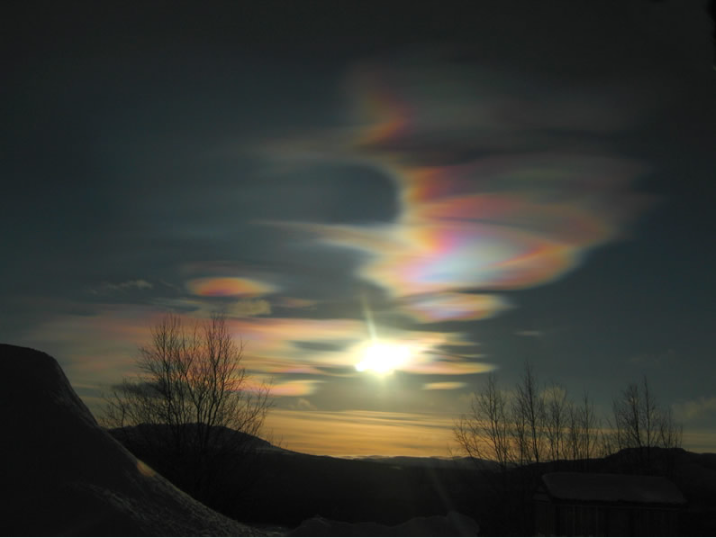Daylight Nacreous Clouds, Norway
Daylight Nacreous Clouds, Norway: A Rare and Dazzling Sight
Have you ever witnessed clouds that shimmer and glow in vibrant colors, defying the usual expectations of the sky? Nacreous clouds, also known as polar stratospheric clouds, are a mesmerizing atmospheric phenomenon that typically graces the heavens during twilight hours. However, there are instances when these ethereal clouds become so luminous that they can be observed during daylight hours. One such extraordinary event occurred on January 20th, 2008, over the Tunhovd fjord in Nore og Uvdal, Norway, leaving spectators awestruck. Photographer Kalinka Irina Martin Iglesias managed to capture the brilliance of these daylight nacreous clouds, so radiant that she even had to shield her eyes with sunglasses to reduce the intensity of the light. Let us delve deeper into this captivating celestial display.
Unveiling the Brightness of Daylight Nacreous Clouds
Nacreous clouds are typically seen when the sun is below the horizon, casting its golden hues upon the sky. Their delicate iridescence emerges as a result of sunlight refracting through tiny ice crystals present in the atmosphere. These ice crystals, formed at extremely low temperatures in the stratosphere, create a spectacle akin to a celestial kaleidoscope. Normally, nacreous clouds remain concealed from our view during daylight hours due to the overpowering brightness of sunlight. However, on rare occasions, the intensity of their luminosity surpasses that of the sun, rendering them visible even in broad daylight.
The Astonishing Daytime Display in Norway
The extraordinary event that unfolded over the Tunhovd fjord in Norway on January 20th, 2008, showcased an exceptional occurrence of daylight nacreous clouds. Kalinka Irina Martin Iglesias managed to capture the breathtaking beauty of these clouds through her lens, preserving the magical moment for eternity. The brilliance of the nacreous clouds was so striking that it defied the conventional expectations of their visibility during daylight hours. To protect her eyes from the dazzling radiance, Kalinka resorted to wearing sunglasses, a testament to the intensity of the light emitted by these celestial phenomena.
Nacreous Clouds: A Rarity to Behold
The sighting of nacreous clouds during daylight hours is an exceedingly rare occurrence. These clouds typically thrive in polar regions, where the frigid temperatures of the stratosphere provide the ideal conditions for their formation. Due to their high altitude, nacreous clouds reside in the lower portion of the stratosphere, roughly 15 to 25 kilometers above the Earth's surface. The rarity of these clouds is attributed to the stringent atmospheric requirements necessary for their existence, including specific temperature and moisture conditions. Therefore, witnessing nacreous clouds during daylight is a truly remarkable event.
Exploring the Science Behind Nacreous Clouds
Nacreous clouds owe their mesmerizing appearance to a phenomenon known as cloud iridescence. When sunlight encounters tiny ice crystals within these clouds, it undergoes diffraction, causing the light to split into its component colors. This dispersion of light creates a stunning display of vivid hues that seem to dance across the sky. The unique composition of these ice crystals, often composed of supercooled water droplets or nitric acid trihydrate, contributes to the extraordinary optical effects observed in nacreous clouds.
The Influence of Atmospheric Conditions
The occurrence of daylight nacreous clouds is influenced by various atmospheric conditions. The presence of exceptionally low temperatures in the stratosphere, typically below -78 degrees Celsius (-108 degrees Fahrenheit), is a crucial factor for their formation. Additionally, the presence of polar vortexes, which are large-scale cyclonic circulations in the polar regions, can enhance the likelihood of observing nacreous clouds. These vortexes create stable atmospheric conditions that favor the formation and sustenance of these remarkable clouds.
The Awe-Inspiring Beauty of Nacreous Clouds
Nacreous clouds exhibit a breathtaking array of colors, ranging from vibrant pinks and oranges to soft pastel blues and greens. These striking hues result from the intricate interplay between sunlight, ice crystals, and atmospheric conditions. As sunlight passes through the ice crystals, it is diffracted and scattered, giving rise to the stunning palette of colors that adorn the sky. The ethereal nature of nacreous clouds has earned them the nickname "mother-of-pearl clouds," alluding to the shimmering iridescence reminiscent of precious pearls.
In conclusion, the rare occurrence of daylight nacreous clouds is a spectacle that leaves observers in awe of the wonders of the atmosphere. The breathtaking display captured by Kalinka Irina Martin Iglesias over the Tunhovd fjord in Norway serves as a testament to the extraordinary beauty that can unfold in the skies above. These luminous clouds, defying the norms of visibility during daylight hours, offer a glimpse into the captivating world of atmospheric optics. While witnessing such an event may be a rarity, the memory of these dazzling nacreous clouds will forever remain etched in the minds of those fortunate enough to behold their radiant glory.

Daylight Nacreous Clouds.
Nacreous clouds are usually seen shining in the darkening sky after sunset or before sunrise.
These, imaged by Kalinka Irina Martin Iglesias over Tunhovd fjord in Nore og Uvdal, Norway on 20th January 2008, were so bright that they were visible in daytime. In fact, Kalinka used sunglasses to reduce the light!
More images of the Scandinavian 19-20th January display 1,2.
©Kalinka Irina Martin Iglesias, shown with permission.
Note: this article has been automatically converted from the old site and may not appear as intended. You can find the original article here.
Reference Atmospheric Optics
If you use any of the definitions, information, or data presented on Atmospheric Optics, please copy the link or reference below to properly credit us as the reference source. Thank you!
-
<a href="https://atoptics.co.uk/blog/daylight-nacreous-clouds-norway/">Daylight Nacreous Clouds, Norway</a>
-
"Daylight Nacreous Clouds, Norway". Atmospheric Optics. Accessed on December 27, 2024. https://atoptics.co.uk/blog/daylight-nacreous-clouds-norway/.
-
"Daylight Nacreous Clouds, Norway". Atmospheric Optics, https://atoptics.co.uk/blog/daylight-nacreous-clouds-norway/. Accessed 27 December, 2024
-
Daylight Nacreous Clouds, Norway. Atmospheric Optics. Retrieved from https://atoptics.co.uk/blog/daylight-nacreous-clouds-norway/.